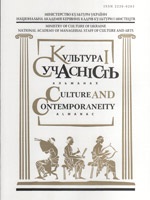Наджанрові й надстильові принципи класифікації електронної музики в умовах масової культури
Super-genre and super-style classification principles of electronic music in mass culture conditions
Author(s): Sergiy LazarevSubject(s): Music, Sociology of Culture
Published by: Національна академія керівних кадрів культури і мистецтв
Keywords: mass culture; electronic music; electronic music classification principles; style; genre;
Summary/Abstract: The purpose of the research is to define new, modern classification principles of electronic music streams in view of the mass culture conditions. The research methodology consists of the synthesis of the of applied mathematical and mathematically philosophical approach analogs used for studying classification and distinction of electronic mass music streams. The methodological basis for the definition of new classification principles of electronic mass music was understanding of the ideas of B. Mandelbrot’s (fractal), D. Gabor’s, A. Aspe’s (holography) and also C. Jencks’s and T. D’an’s concept of double coding comprehension in the projection of modern musical art; as well as works of musicologists V. Holopova, O. Andruschenko and theoretical researches made by composers R. Shchedrin, I. Stetsiuk and M. Abakumov (third stream). Scientific novelty lies in the identification of new super-genre and supert-style classification principles of electronic music in the conditions of mass culture (fractal -holographic, ternary). Conclusions. The usage of new electronic mass music classification principles described in the article enables: definition of certain musical streams taking into consideration the extremes of the appropriate number of indicator works, which should be classified according to their focus on commercial and non commercial type within one stream (fractal-holographic principle); division of electronic music into three main streams: the first – serious, academic electronic music, second – easy, entertaining electronic music and the third – a boundary stream that has absorbed some of the features of the first two, namely author and performer professionalism of the first stream and focus on the mass audience of the second stream through the lens of postmodernism trends (ternary principle).
Journal: Культура і сучасність
- Issue Year: 2017
- Issue No: 1
- Page Range: 133-140
- Page Count: 8
- Language: Ukrainian

